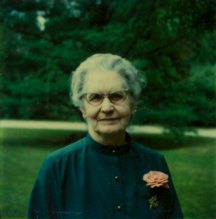Jessie’s story
Told by Jessie Lee Cashwell Boney to her daughters
When Mama (Anna Matthis) and Papa (Joseph Leon Cashwell) married, in 1902, Papa was working on a farm in Duplin County. In 1903 they moved to Sampson County, where Papa became the overseer of the Wright farm. During the move from Duplin to Sampson, Jessie was born in the home of her maternal grandparents. (We now call this house the Matthis Old Place. Gladston Matthis and his sister Ellen Ward—Jessie’s first cousins—live there now.)
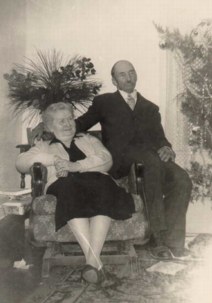
Anna Matthis and Joseph Leon Cashwell
(“Mama” and “Papa”)
Jessie Lee Cashwell was born on January 3rd, 1903. In her words, “Sometimes I wonder about the real truth of those who say they remember being in their mother’s womb. As I’ve racked my brain for the first memory, I think it was when my brother—two and a half years younger than I—was born. I have a vague recollection of much commotion, more people in the house, and I was cared for by loving grandparents who let me wear their spectacles. Later, they bought a pair of red shoes for me.”
In 1904 an infant was born prematurely, when Mama was ill with Rubeola (known as the “red measles”), and the child died unnamed.
“During my first four or five years we lived on the campus of Mrs. Wright’s private boarding school. I can remember times when students would come to our home and beg Mama to give them teacakes or biscuits.” The school closed when North Carolina began increasing public schooling, no longer stopping at the seventh grade but going on through the eleventh. All of the Wright children were college educated: one became an ophthamologist, another a civil engineer, and another—Robert Herring Wright—the first president of Eastern Carolina Teachers Training School (later to become Eastern Carolina Teachers College, and then East Carolina University).
“After Marie was born we moved across the road to a farm Papa had bought. Some years before, with the help of his father-in-law, Papa had built or finished building a house on the property.” (This is the house we now call the Old Place—not to be confused with the Matthis Old Place!)
“I have a vivid memory of the day my sister Marie, the third child, was born. The doctor came in the morning and Papa took me to spend the day with Miss Betty, who was Mrs. Wright’s daughter. She was a lot of fun and I had a happy day.
“When I was six, I started to school, a one-room school with seventeen grades. The teacher lived near us, so I walked the one to two miles with her. I cannot remember when I could read, but when I was about ten years old, my second brother, Joe, started school, and the teacher taught reading by using phonics, which was new in our part of the world. I’ve always been grateful for having learned that method. I finished the seventh grade. The requirement for passing was a standardized test. The only thing I can recall of the test was ‘draw a turnip on a table’. I never could draw, but I passed the test. When the schools closed [for the year] all the seventh graders in the county who passed went to the county seat for graduation exercises, which were held outdoors in front of College Street School in Clinton. It was a beautiful day, chairs all over the lawn, and the speakers spoke from the steps. I wore a white dress!”
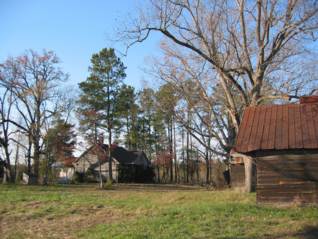
The Old Place in 2002, long unoccupied
Papa continued farming after the family moved to the Old Place. Farming provided most of the needs of the family. Some of the produce, such as fresh vegetables, and cured hams and pork shoulders, was sold to passersby. There was no tobacco or other significant cash crop. Papa grew corn and took some of it to a mill for grinding, the miller keeping some of the cornmeal in exchange for his work. Oats were grown for the horses.
Papa grew “cane” (sorghum) and at harvest time the canes were stripped of the leaves. Then men came with equipment for making sorghum syrup, a mule providing the power to drive the machinery for crushing the cane and extracting the juice. They reduced the juice into syrup by slowly heating and stirring it in large pans over a fire. The leftover crushed stalks were fed to the hogs. There were also cows, chickens, sheep and—for a time—goats on the farm. The goats had a special sleeping loft that they climbed up to by way of a ladder. Wool from the sheep was sent off to a company to be traded for clothes and other goods.
Timber was harvested and sold for cash. A Mr. Caison had two mules to help pull logs out of swampy areas. He sometimes stayed at the Old Place while he was logging in the area. He played the banjo, singing funny songs such as “The Preacher and the Bear”. One of his mules was killed by a falling tree and Jessie remembers him being very upset by the loss.
A Miss Herring taught at the local one-room school for a year, and she stayed with the Cashwell family in the winter. Jessie remembers that no teacher ever stayed at the school for more than a year. Uncle Marshall, Mama’s brother, taught there one year, staying with the Cashwells during the week. He made the students learn the names of all the counties and county seats in North Carolina. Uncle Albert, another brother, would bring Marshall to school on Monday and take him home on Friday. Albert was not then married and still lived in the Matthis Old Place where Mama, Marshall, Albert, Lena, and Bud had been born.
During his teaching year, Marshall “switched” two of his young relatives. Marie misspelled “fish” as “fich” and refused to spell it correctly after being told how. Uncle Marshall sent Marie's brother Jim outside to fetch a switch—and he brought back a big one. Marie was switched “a little bit”. On another occasion, Marie was sent to get a switch because Jim could not spell “melancholy”, even with repeated correction. Marie picked a very small switch, and Jim was given his switching.
Mama never prepared a chicken for cooking—cutting off its head, dipping it in hot water, and plucking the feathers. It was Papa’s job until the children were old enough. Mama also never cleaned fish, but she liked to have fish for the table. Her father had often fished to feed his family. Papa didn’t like to fish, but he did it anyway to please Mama. He fished in Little Coharie Creek behind the house. Papa never drove a car. The first automobile in the area belonged to Dr. Sloan in Garland. Jessie got to ride in it once. (Editor’s note: This Dr. Sloan was probably a relative of Jessie’s, although the family may not have known this at the time.)
Jessie took piano lessons from Miss Meda Highsmith, who lived about five miles away in Parkersburg. One day when Jessie was ten or so, she started off to her lesson on horseback. It was a very hot day. The horse trotted along until they came to a big shade tree by the side of the road where the horse stopped, then turned and galloped home with Jessie still on his back. But she was determined to have her piano lesson, and so she walked the long way to Parkersburg and back.
When Jessie finished seventh grade, there was no public high school in the area, so she was sent to a private boarding school called PSG: Pinelands School for Girls. She earned her diploma in 1920. In 1918, while Jessie was at PSG, all of the family back home became severely ill with the flu. Neighbors took care of them, and all of them recovered. Gladys was the baby then. During the epidemic, Jessie and the other students and faculty at PSG were kept at school, and none became sick. But during this quarantine Jessie had no knowledge of her family’s state of health. (The 1918 flu was a devastating global epidemic, killing millions, so it is very fortunate that the family all survived.)
The family moved from the Old Place to Ingold in 1920, and the rest of the children went to school at Ingold High School. Mama had taken in boarders from time to time at the Old Place, and she continued this in Ingold on a more regular basis, taking on “hired help” to assist with the chores. Mama loved flowers and grew as many as she could around the house.
Mama did much of the cooking. She made biscuits and teacakes and pound cake. She had a large scooped-out board in which she worked up the batter, using her hands to mix the ingredients. Jessie also has childhood memories of the pantry at the Matthis Old Place, full of wonderful odors from the apple cobblers, pound cakes and teacakes that her grandmother (Ellen Robinson Matthis) made.
Mama gave nicknames to some of her children. Jessie's was often called “Rossie”, after a large woman with a heavy walk, because Jessie reminded Mama of “Rossie”. Marie was called “Emma”, after a cousin of Mama’s, as both tended to cry easily. If she heard Marie crying, Mama would say, “Well here comes Emma!”
Jessie went to Meredith College in the fall of 1920, but the Farm Depression of that year left the family unable to afford Jessie’s tuition for more than a semester. She went to Alabama to teach in a girls’ school started by two sisters—Bonnie and Pearl Howard—who had taught at PSG. Jessie stayed there for a year and a half, then returned to North Carolina because she missed home. She taught in Pitt County for a year and then in Sampson County Schools for three or four years. School sessions were short then, about four months per year, so that children could help their families with farm work. Also, there was not enough money to pay the teachers for longer sessions. They were paid by the county until the state began paying them with the North Carolina sales tax.
Jessie spent four summers at Eastern Carolina Teachers Training School (now ECU) and one summer at Western Carolina Teachers Training School (now WCU), her last schooling. She was six weeks short of earning a teacher’s diploma. Her salary covered her college expenses. Between summer and the few months of teaching each year, she lived at home in Ingold. Jessie said, “It was always a Depression at our house”, referring to the lack of money to pay for a full education for all the children. However, five of the children earned college degrees or teaching certificates. Two of them had Masters degrees, one was an R.N., one had a one-year business degree, two had two or more years of college and one of them earned a horticultural degree after retirement.
The early teacher training schools such as ECTTS and WCTTS had courses on how to teach various subjects to children, but didn’t have courses on the subjects themselves, according to Jessie. There were courses on how to teach children’s literature, math, history and geography—the latter “a big thing” for teaching at that time. One of Jessie’s teachers at Pineland School for Girls was Mattie Mills Corbett, who taught geography. She married C. C. Corbett of Clinton. He had given money to PSG and his name was prominently displayed at the school. Mattie Corbett later taught at Clinton Grammar School, when Jessie’s daughters were there from the first through the seventh grades. Mrs. Corbett taught a class for children with difficulty learning.
Jessie was 21 when she was teaching at Oakland (near Dunn), at a school which has since merged with another school. She taught combined third and fourth grades. On some weekends and holidays she took a “taxi” from Dunn to Clinton. It was really a bus, carrying a lot of people. Someone from Ingold would meet her in Clinton. Jessie married Landron Clifford Boney in 1927, in a preacher’s house, in a town between Clinton and Raleigh (possibly Jonesboro). Jessie and Landron each had a brother at State College then: Jessie’s brother Jim (the oldest of her brothers and sisters), and Landron’s brother Yancy (the youngest of the seven children in his family).
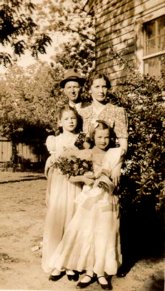
Landron and Jessie with Rosemary and Dixie at the College Street house
Jessie and Landron lived in a house on Johnson Street in Clinton, along with some of Landron’s family: his mother, his brother Cyrus, and his sister Betsy. Landron’s brothers Leon and Yancy would visit the house. The oldest of his siblings, Matt and Addie, were both married and living away.
Lynette, born in 1928, was the oldest of Jessie and Landron’s three girls. Rosemary was born in 1930. That year or the next, the family moved next door to a house that Landron had built. Dixie was born in this house in 1933. When she was not quite a year old, her mother dropped her in the front yard. Rosemary was following her older sister across the street, and was hit by a car. Jessie rushed to her, dropping Dixie in the process. Dixie was not hurt, but Rosemary suffered a fractured leg and had to wear a cast for many weeks, which must have been very uncomfortable in the hot summer weather. Especially after she came down with chicken pox. Of course there was no air conditioning then!
Mama and Papa had sold the Old Place in 1920. But after two years or so, the new owners left. Landron later bought back the Old Place, which was being sold by the county for back taxes. Farming was continued there with tenants.
Jessie and Landron and the girls moved to 705 College Street to be closer to the Grammar School, and also to have more room. The house had been built in about 1870. Landron was a building contractor, and he renovated the house before the move. The property had several large pecan trees, two black walnut trees, a maple and one large oak tree. There was room in the back of the property for a large vegetable garden and a grape arbor. There were also two outbuildings: a large garage and another building that Landron renovated to create “the Playhouse” for the children.
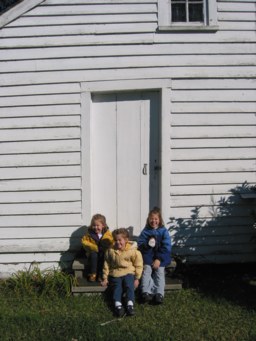
Cecelia, Zoe and Emmalee—three of Landron and Jessie’s great granddaughters—in front of the Playhouse
When the family moved to College Street, Landron’s siblings Cyrus and Betsy and their mother moved into their old house on Johnson Street. Neither Cyrus nor Betsy ever married, and they continued living in the Johnson Street house after their mother died. Cyrus worked for Landron as a carpenter and also grew crops on the land he inherited from his father. Many years later, after Betsy and then Cyrus had died, the property was bought by the hospital nearby, and the house and garage were demolished.
Cyrus Boney served in the Army in World War I and was sent to Europe. Landron was not eligible for service because of a childhood accident that left him with limited movement of his right elbow, and one leg shorter than the other. Four of the Cashwell children served in four different branches of the military during World War II: Joe in the Navy, Gordon in the Army, Manley in the Air Force, and Dolores in the WAVES.
Gordon was single until the late 1940s, and had sent money each month from his Army pay to his mother. Mama saved it all, and when Gordon returned home Gordon and Mama used the money to buy back the Old Place from Landron. When Gordon was married and it became apparent that he would have no children, Mama put in her will that Gordon was to have the Old Place as long as he lived. On his death, it was to be given to his siblings still living. Gordon was survived by his sisters Jessie, Marie and Dolores. Marie died two months later, leaving Jessie and Dolores—the oldest and the youngest of the siblings.
Jessie Lee Cashwell Boney died on December 30th, 2002—four days short of her hundredth birthday.
